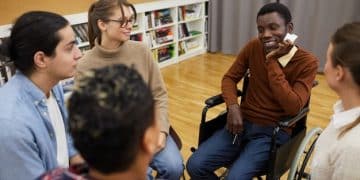Digital Literacy Champion: Bridging the Education Gap for Seniors in the US

The Quiet Activist tells the story of a librarian in the US who is dedicated to bridging the digital literacy gap for seniors, empowering them through technology education and access to essential online resources, enriching their lives and connecting them to the modern world.
In an era dominated by technology, many seniors find themselves struggling to keep up. But one librarian in the US is quietly making a difference, dedicating her career to bridging the digital literacy gap and empowering older adults to navigate the digital world with confidence. Meet The Quiet Activist: How One Librarian’s Dedication to Digital Literacy Is Bridging the Education Gap for Seniors Across the US.
The Growing Digital Divide Among Seniors
The digital divide, the gap between those who have access to and the ability to use technology and those who do not, disproportionately affects seniors. Factors such as cost, fear of technology, and lack of training contribute to this disparity, leading to social isolation and limited access to essential services.
Many seniors may feel overwhelmed by the rapid pace of technological advancements, making it difficult for them to engage with the digital world. This can have significant implications for their well-being and independence.
Understanding the Challenges Faced by Seniors
Seniors face unique challenges when it comes to adopting new technologies. These challenges can range from physical limitations to cognitive barriers, all of which require tailored solutions.
- Physical Limitations: Arthritis, vision impairment, and hearing loss can make it difficult to use devices like computers and smartphones.
- Cognitive Barriers: Memory loss and difficulty learning new skills can hinder the adoption of digital technologies.
- Anxiety and Fear: Many seniors are apprehensive about using technology, fearing they will make mistakes or be scammed.
Addressing these issues requires patience, understanding, and a willingness to adapt teaching methods to meet the specific needs of older learners.
Overcoming the digital divide requires addressing these challenges head-on. With the right support and resources, seniors can learn to navigate the digital world confidently and safely. She helps seniors overcome these fears by providing patient, one-on-one instruction, breaking down complex concepts into manageable steps.

Meet the Librarian: A Champion for Digital Inclusion
In countless communities across the United States, there are unsung heroes working tirelessly to make a difference in the lives of others. Among these is a dedicated librarian who has made it her mission to ensure that seniors are not left behind in the digital age.
This librarian, often working quietly behind the scenes, is committed to providing seniors with the skills and resources they need to thrive in an increasingly digital world.
Her Background and Motivation
Driven by a passion for lifelong learning and a deep understanding of the challenges faced by seniors, this librarian recognized the critical need for digital literacy programs tailored to older adults.
- Personal Experiences: Witnessing her own family members struggle with technology inspired her to take action.
- Community Needs: Recognizing the lack of resources for seniors seeking digital skills, she developed targeted programs to address this gap.
- Empowerment Through Knowledge: She believes that digital literacy can empower seniors, enabling them to stay connected, access essential services, and engage with the world around them.
Her dedication to digital inclusion stems from a belief that everyone, regardless of age or background, deserves the opportunity to participate fully in the digital age. She envisioned a place where seniors could learn, explore, and connect with others in a supportive environment.
For her, digital literacy isn’t just about learning how to use computers; it’s about empowering seniors to lead more fulfilling and connected lives. Through workshops, one-on-one tutoring, and community outreach, she has touched the lives of countless seniors, helping them overcome their fears and embrace technology with confidence.
Innovative Programs and Initiatives
To effectively bridge the digital literacy gap, the librarian has developed a range of innovative programs and initiatives designed to meet the diverse needs of seniors. These programs are tailored to address common challenges and provide hands-on learning experiences.
These initiatives are designed to be accessible, engaging, and relevant to the lives of older adults, ensuring they can immediately apply their new skills.
Tailored Workshops and Training Sessions
The librarian offers a variety of workshops and training sessions that cover essential digital skills, from basic computer operations to online safety and social media literacy. She designed her workshops to be interactive and hands-on, allowing seniors to learn by doing.
- Basic Computer Skills: Introduces seniors to computer hardware, software, and basic operations like typing and using a mouse.
- Internet Navigation: Teaches seniors how to use search engines, browse websites, and evaluate online information.
- Email Communication: Covers how to create an email account, send and receive messages, and manage contacts.
She often uses real-life scenarios to illustrate the benefits of digital literacy. For example, she might show seniors how to use online banking to avoid trips to the bank or how to video call their grandchildren who live far away. Participants learn to use email to stay in touch with family, access online healthcare portals, and navigate social media to connect with friends.
The librarian also emphasizes the importance of online safety, teaching seniors how to recognize and avoid scams, protect their personal information, and use strong passwords.
Building Confidence and Overcoming Fears
One of the biggest challenges in bridging the digital literacy gap is addressing the fear and anxiety that many seniors associate with technology. It’s very common for older adults to feel overwhelmed.
Here are some effective strategies for promoting trust and confidence in technology among older adults.
Creating a Supportive Learning Environment
To foster a positive learning environment, the librarian emphasizes patience, encouragement, and a non-judgmental approach. She understands that seniors may need more time to grasp new concepts and encourages them to ask questions without fear of embarrassment.
- Small Class Sizes: Allows for more individualized attention and personalized instruction.
- Peer Support: Encourages seniors to learn from and support one another, creating a sense of community and shared learning.
- Positive Reinforcement: Provides positive feedback and encouragement to build confidence and motivation.
The librarian’s classroom is a safe space where seniors feel comfortable experimenting, making mistakes, and learning from each other. She constantly reminds them that it’s okay to ask for help and that everyone learns at their own pace.
She celebrates small victories, such as sending their first email or successfully navigating a website, to reinforce their sense of accomplishment and build their confidence.
The Impact on Seniors’ Lives
The librarian’s tireless efforts have had a profound impact on the lives of seniors in her community. By empowering them with digital skills, she has opened up a world of opportunities and enhanced their quality of life.
The outcomes are evident in various aspects of their lives, from improved social connections to enhanced access to essential services.

Improved Social Connections
Digital literacy has enabled seniors to stay connected with family and friends, combatting social isolation and loneliness. Those who were once isolated now participate in online communities, share photos with family, and even video call their loved ones regularly.
- Staying in Touch: Email and social media platforms allow seniors to communicate with family and friends who live far away.
- Online Communities: Seniors can join online groups and forums to connect with others who share their interests and experiences.
- Video Conferencing: Platforms like Zoom and Skype enable seniors to participate in virtual meetings, attend online events, and stay connected with loved ones.
These connections not only improve their mental well-being but also provide a sense of belonging and purpose. This increased social engagement helps combat feelings of isolation and loneliness, improving their overall quality of life.
One senior, for example, was able to reconnect with her childhood friend who lived in another country through social media, rekindling a friendship that had been lost for decades.
Looking Ahead: The Future of Digital Literacy for Seniors
As technology continues to evolve at a rapid pace, the need for digital literacy programs for seniors will only continue to grow. It’s essential to advocate for policies and programs that support digital inclusion and ensure that older adults are not left behind.
Sustaining and expanding digital literacy initiatives requires a collaborative effort involving libraries, community organizations, government agencies, and technology providers.
Expanding Access to Technology and Training
To ensure that all seniors have the opportunity to acquire digital skills, it’s crucial to expand access to affordable technology and training programs. To continue bridging the digital divide, it’s vital to invest in resources that empower seniors to become confident and capable digital citizens.
- Affordable Devices: Provide seniors with access to low-cost computers, tablets, and smartphones.
- Accessible Training Programs: Offer free or low-cost digital literacy workshops and training sessions in convenient locations.
- Technical Support: Provide ongoing technical support and assistance to help seniors troubleshoot problems and navigate new technologies.
By investing in digital literacy for seniors, we can create a more inclusive and connected society where everyone has the opportunity to thrive in the digital age. This commitment ensures that older adults can remain active, engaged, and empowered members of their communities.
| Key Point | Brief Description |
|---|---|
| 💻 Digital Divide | Seniors face challenges in accessing and using technology. |
| 👩🏫 Librarian’s Role | Dedicated librarian bridges the digital literacy gap. |
| 🤝 Community Impact | Seniors improve social connections and access services. |
| 💡 Future Outlook | Expanding access and training is crucial for seniors. |
FAQ
▼
Digital literacy improves social connections, access to services, and combats isolation. It empowers seniors to engage with the modern world and enhances their quality of life.
▼
Seniors often face challenges such as physical limitations, cognitive barriers, and anxiety related to technology. Tailored training programs can help address these issues.
▼
Libraries offer free access to computers, internet, and digital literacy training. Librarians provide support and guidance, making technology accessible to everyone in the community.
▼
Programs cover basic computer skills, internet navigation, email communication, and online safety. They focus on practical skills that seniors can use in their daily lives.
▼
You can volunteer at local libraries, donate to digital literacy programs, or advocate for policies that support digital inclusion. Spreading awareness also helps to encourage participation.
Conclusion
The Quiet Activist: How One Librarian’s Dedication to Digital Literacy Is Bridging the Education Gap for Seniors Across the US underscores the profound impact of grassroots efforts in bridging the digital divide. By championing digital literacy for seniors, this librarian inspires us to recognize the potential within our communities to uplift and empower all generations in an increasingly connected world.





